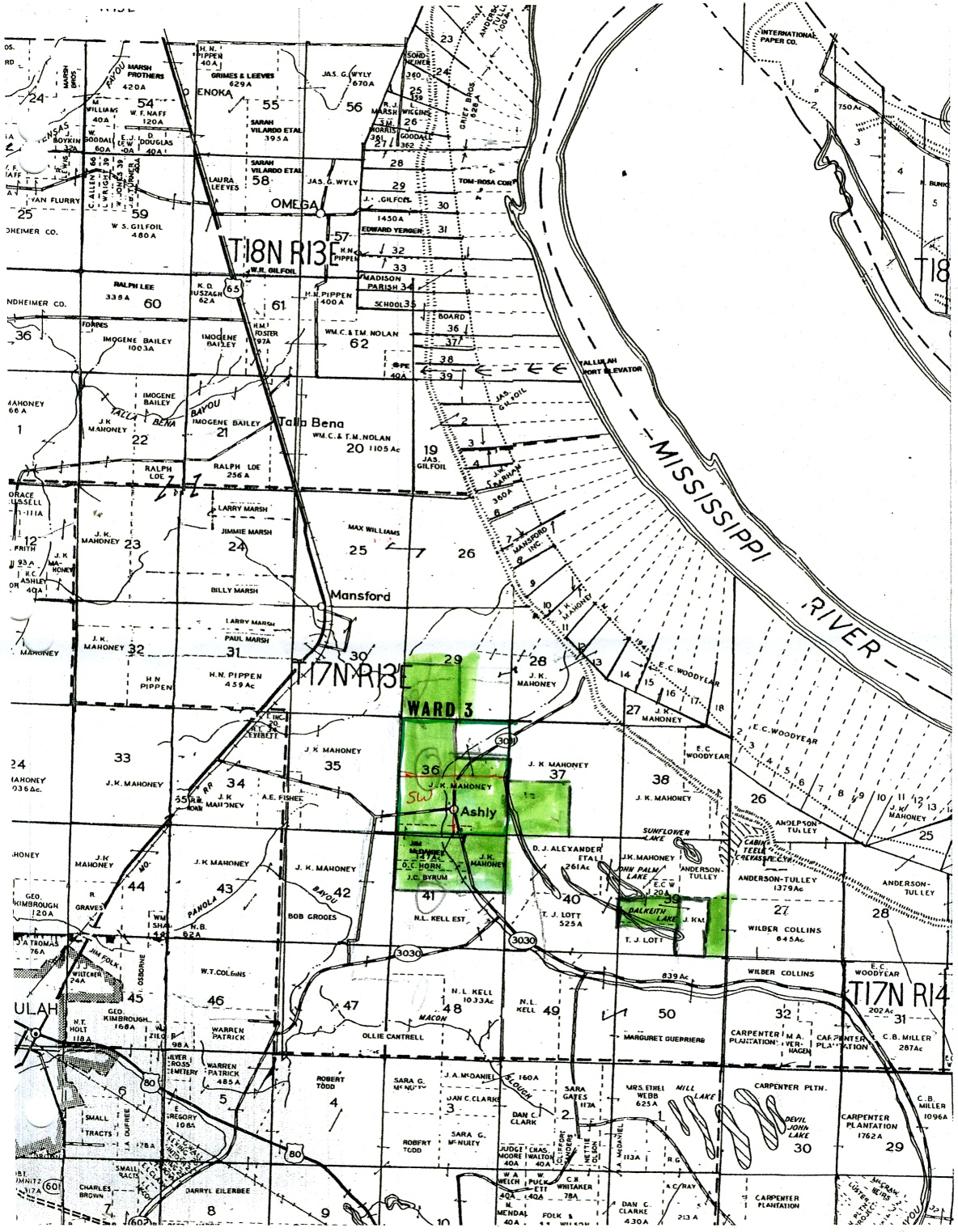
Original Oak Grove in Green
Ashly
John Earl Martin December 2015
Milliken's Bend Preface1
Milliken's Bend, a hamlet of Madison Parish, on the bank of the Mississippi River, was a notable shipping point for the great cotton plantations forming its background.
In its hey-day it represented wealth and culture, boasting such good names as the Morancys, from San Domingo, The Bauers, from Germany, the McClellans, Coltharps, Yergers, Seviers2 and many others, adept in the art of good living and free spending. Tottering Ole Timers will tell you that "Those were the days!" when, over-extended sessions of "draw" and "stud", black cigars were literally lighted with crackling "green-backs" and goodly acres balanced on the cast of a dice!
At infairs, balls and tournaments, Beauty's Eyes were toasted in glittering champagne; stately chaperones sipped sherry and elderberry, on the sidelines, while their spouses savored the aroma of old Burgundy.
We know that the "Ladies of the Bend" took their housekeeping with pride and seriousness, and vied with each other in the excellence of their beaten biscuit, their muscadine jelly and Sally Lunn3 .
To them and other women of the Deep South goes the credit of training a race of cooks and handing down valued recipes to another generation.
The men looked over their wide acres with an eye acquaint with the vagaries of cotton and, over frosted juleps, they were not unmindful that their comfort and content rested on the bowed backs of slaves and the conformity of a mighty river.
The unwelcome advances of this river caused the town to be "moved back" three times, with consequent loss and inconvenience. Milliken's Bend boasted a "Male and Female Academy", established in 18444 , but its chief claim to other than local distinction lies in the fact that, due to its strategic situation, in a bend of the river--on the Louisiana shore--just above Vicksburg. It was headquarters for three Federal generals of the Civil War. First, there was Corps XIII under McClernand, Corps XV, under Sherman, and finally Grant, accompanied by a flotilla of gunboats, ascended from the north, taking entire command and, from this point, evolving his successful advance on Vicksburg5 . For this distinction, naturally, the town paid in pain and pillage, but emerged in time into a pale reflection of former glory. The great river boats, graceful as swans, glided with tinkling bells and gruff commands, into its shores, exchanging varied merchandise for up-piled cotton bales destined for the far places of the earth. All seemed well; but Milliken's Bend was never quiescent, and in the disastrous flood of 1927 it was buried under chilly waters. The river that brought it wealth and prominence furnished it winding sheet.
A few sagging roofs and tottering chimneys emerged, after a night of horror, and only the cross on the Catholic chapel, where the beaux and belles had murmured Ave Marias, in repentance of the week's frivolities, stood fair in the sunshine, a fateful reminder of the transiency of man. The "Bend never came back from this disaster; of all its lovely homes, with their widespread gardens, only the old Yerger house remains, and a few squatters and fishermen cling to the river bank, trafficking picturesquely in bootleg, blackberries and channel cat, but the little town secured its immortality on the pages of history and in the hearts of its people!
ASHLY
This title may seem misleading, but is compiled to tell of the formation and the outcome of a large number of Madison Parish plantations. Because of the enormity of what we know today as "Ashly", I chose to concentrate on what I consider to be the "core" of the entity, Oak Grove Plantation, which the Company was built around. Oak Grove was one of the many plantations founded in the proximity of the trading settlement of Milliken's Bend6 after 1802, being mostly settled after the opening of the region and surveying by the Federal land Office, primarily in the 1830's and 1840's. January 1961 a highly regarded map of the area by Dr. Edwin C. Bearss shows Oak Grove headquarters in 1863, was west of south of the road intersection, and the spot where Kennedy's home is being listed as belonging to Dr. Gibson of Brokenburn. Oak Grove was described in an 1857 transaction recorded in the Madison Parish Clerk's Office in Book E, p. 506 that Sarah Clark Lane, Widow of John Lane, sold to Edwin M. Lane Oak Grove Plantation, 1360 acres described as: T17 R13; sec 29 SW; Sec.41 N/2; sec 37 SW; sec. 39 N/2 of SW and E/2 of SE; sec. 36 except N/2 of NE. This property was sold by Edwin Lane's estate at sheriff's sale in 1868 to John Hiddleston of New Orleans who in 1869 sold back to Mrs. Lane, describing it as being bounded on the north by Compromise Plantation owned by Allen Jones, on the S by Orkney, owned by B. H Buckner, on the E by Phillip Maher's land, and on the west by Burkland owned by Humphreys. In 1869 General Frances P. Blair moved back to Madison Parish and "leased" Cabin Teele Plantation near Oak Grove to farm cotton. Being a military man, he began by lining up his men at the edge of the field and ordering "March"! It's not hard to imagine how that turned out. Then he instituted the "tenant lease" system which had been in use in the smaller hill country farms of Louisiana. This was also successful in his case. In 1868, a new player enters. Ms Mary C. Waddill who bought a still highly desirable tract of 190 A on Joe's Bayou north of Waverly. Keep in mind that this was in the period of Federal occupation and her husband, Ex-Confederate Major George C. Waddill was still disenfranchised. On the deed she is explicit that she is independent and in her own right in obtaining the mortgage. Their address is listed as Dallas (now Tendal). Major Waddill was acquainted with Dr. Henry Wirz of Milliken's Bend, and was instrumental in the appointment of Dr. Wirz as Commandant of Andersonville Prison in Georgia. This position, of course, resulted in Dr. Wirz being charged with war crimes and executed, being the only Confederate so charged. In 1875 part of section 36, west of Walnut Bayou in the center of Oak Grove was sold by a Steven Duncan to Newitt Drew and in 1876 Duncan sold the N/2 of NE sec. 36 of Walnut Bayou to the afore mentioned Mrs. Waddill as well as several small tracts in sec. 27, 28, 37, 38, 13,14. This deed describes the property in sec. 36 as containing a dwelling house near the bayou. She reiterates that she is independent of her husband, but has his full support. Mary & George C. Waddill, Geo. A. Waddill from this point on until the early 1900's when they bought from the Government Land Office a 38 A tract in 1902. This tract is on the north side of Tensas River on the approximate spot of Ron Hilderbrand's shop near Tendal today. They bought land all over the parish including woodlands, notably much acreage eventually bought by Singer. Now, back to Oak Grove in 1877, Mrs. Louise Lane (Ms Joshua Clark) traded 2/3 interest in Oak Grove to William Lane and John Lane for secs. 42 and 43, who in 1879 sold to John King and Hewitt Vick Lane who sold to Steven Duncan. In 1881 Duncan sold N/2 of NE sec. 36 to Mary Waddill that had been withheld from several transfers !Mystery! And in 1883 Vick and Lane sold to G. A. Waddill 1368 acres of Oak Grove to include everything on the place, as well as paying off several mortgages. In 1886 the Waddills combined their properties, forming the Ashly Co., Ltd. With George C. Waddill as President; George A Waddill as Vice President and T. C. Bedford as secretary. Board members were JHC Bowmar, Ed Farrar, A. D. Pittman and Murray Smith, with F. L. Maxwell and W. H. McFarland witnessing. The Waddills sold 60,000 A to Ashly Ltd. In 1888, and were joined by 2 more real estate movers (industry giants) in Albert S. Caldwell and W. H. Ward. Caldwell ascended into the presidency of Ashly Co. in 1896. In 1907 Ashley Co. Ltd sold to Deltic Investments of Dundee, Scotland. The period beginning with Deltic ownership was one in which the lands were rented to individuals who were answerable to Mr. W. F. Powell, then agent in Madison Parish. I know nothing of early renters, but in the early 1920's we see the John Clark Byrams and their kinsmen, the Westmorelands from Caddo Parish who along with the P. B. Thigpens rented large tracts of the land. Soon to follow in the early 1930's the J. D. Martins, T. D. Murphys, the Coxes, and the Browns, Bud, Jess and Clarence. (Only Martins and Murphys lived on Ashly along with Byrams and Westmorelands.) When Britain was engulfed in the terrible World War II, they were forced to have all their citizens to cash in all their foreign investments to support the war effort. Accordingly in 1941 Deltic Investments sold some 42,000 acres to J. K Mahoney & Charles H. Murphy, big oil and real estate people for $10 per acre. Their company, the Murphy Co., took over ownership and began farming the land in 1943 for the crop year of 1944. In 1946, the families of C. H. Murphy, and the Nolans, Kellers, and Demings, C. H. Murphy Jr., combined their assets under the name C. H. Murphy a Co. with C. H. Murphy, Jr. as managing partner. Then in 1950, C. H. Murphy & Co. was incorporated as the "Murphy Corporation". In 1958, the lands became Deltic Farm & Timber and shortly afterward became Deltic Timber, Inc.7 In 2001, Deltic Timber put its farming operation up for sale in various sized tracts in Madison and East Carroll parishes. At this point, Deltic was owned by: Murphy Family 57% with the remaining 43% owned by the Mahoney, J. A. Roland, H. C. McKinnon, O. G. Murphy and M. G. Wade families. At this time there was over 40,000 Acres under cultivation. In this sale, they found an eager market, as besides the massive Ashly Plantation, which included Ashly East, Ashly North, Ashly West, Lakeside, Wigwam and Tamarack, there were many smaller tracts that had been rented by individuals for years. The only lands in the area exempted from sale was the great Epps Plantation, known in its early days as Holt & Murphy. This place sprawls into three parishes. Mr. Murphy insisted on keeping this place, now known as "Hard Bargain" Farms. Hard Bargain is ably led by Mr. Bill Lambert, former General Manager over all the farms, and Robert Warren, long-time farm manager. Incidentally, Lambert led Ashly and Madison Parish into "no-till" farming when he was Ashly manager. This revolutionary change since 1990 has come to be totally accepted in various forms in the state and maybe the south. The John Terral family bought the part of Ashly East that includes most of Oak Grove lying between Ashly Road and Mansford Plantation and from US 65 highway to the Thomastown-Milliken's Bend Road. The balance of Oak Grove and Ashly East went to R. T. Kennedy. Both owners have improved their holdings, and both have model farms. ASHLY & 1930'S & 40'S
At this time, this writer lived at the intersection of Thomastown Road to Milliken's Bend Road and Ashly to US 65 highway in a house that stood there until 2012 when it was dismantled and moved for a camp. Have no idea when it was built, but was originally two-story, and I believe to be pre-1927 flood. The Byram house, which I believe to date from the Ashly Co. Ltd days, occupied a lot adjacent to Todd Kennedy's beautiful home across Walnut Bayou and north a short way from the intersection. The road to Milliken's Bend from Kennedy's house was lined with tenant houses, several on small tracts of land that were holdovers from earlier days. Viola and Neola Page were some of these inhabitants. Viola's son, Arthur Lee Page worked for Ashly Plantation his whole career, and retired from the company and now lives wit his wife in Tallulah. These small tracts were bought by Ashly after they bought the surrounding land. These tracts probably date from the Compromise Plantation and Oak Grove Plantation days. Many of Tallulah's citizens have told me that "Grandpa" or "Granmaw" or "Momma" or "Daddy" was born or raised on Ashly, or had worked there and many of the names from that period are still vivid: There was Arey T. Robinson (Peanut Babe) and son Murray, and daughter "Whisky", the Godina family, the Olivoe family, Rev. Alf Pullen & Ms Gussie, Mr. Benny, school teacher at Ashly School (located where Jim McDaniel's home was) Ms Rosie and son Ba-Ba Wyly, Abel and Letty Hunt & son Tom, William Brantly and my father's right-hand man, Son Pet and wife Birdie and Mr. Byram's men, Percy, Emile and Skip. Added to the Byrams, Westmorelands and Thigpens, Murphys and Alexanders, and the two "Mr. Hewes" were the Franklins, Freemans, Floyd Smiths, Cecil Lloyds, Clyde Lawtons, the Tingles and the Lewis Watts families. This was the "Milliken's Bend Community". If you want to start a conversation in Tallulah, just tell somebody that you were born "on Ashly".
Appendices
1. "Early Settlers East side 1830's" Early Settlers by Dick Sevier 2. "Early Settlers, West Side 1840's" Early Settlers by Dick Sevier 3. "Compromise Plantation Story" Curtains for the Bend Frances Alexander 4. The Waddill Family, George C., Mary, Ida B. and A.M. 5. W. M. Scott a Shirley Plantation Book M. 41 6. "Tidbits of local color" Madison Parish Clerk's Office a. Bailey ft S. R. Loe 1948 b. J. B. Snyder from Deltic Q645 1915 c. Clarendon Mower to Harvey Oaks 1937 d. Deltic to A. J. Boswell 51A, 1937 BB58 e. Elizabeth Gibson to P. B. Thigpin 1942 420 A f. Dr Palmer 1937 50 A from Deltic g. Chicago Mill to R. N. Ware 1955 h. Nolan Family
Appendix 1 Early Settlers East side 1830's J. M. Walt 1837 George Wyche 1837 Thomas Borland 1846 Haynes Et Mitchell 1837 Isaac Franklin 1829 Issac Watts 1837 Conway Nutt 1837 James Erwin 1844 Edward Lee 1837 Appendix 2 Early Settlers West of Hwy US65 1840's J. Graham 1843,44 Elhannon Morris 18499 George Copley 1842 F. Stanton 1848 Levin Marshall 1848 John Blakey 1846 Thomas Wells 1842 James Head 184310 John Coons 1843 Thomas Batte 1848 Allen Pierce 1845 Nicholson Barnes 1843 Appendix 3
Compromise Plantation, according to Miss Francis Alexander, author of Curtains for the Bend, written in 1941. "Back in the 'Steamboat to New Orleans' days when the trip was 'the thing', drinking and high stakes poker games were the rage. In 1869 Allen Jones was owner of "The Wall Place" and other places nearby but this is not to say that Jones was the one who earned the sobriquet; seems that the owner of the properties had lost heavily in a card game, and gambler-wise, put up his plantation and of course lost. A mutual friend of Jones' and the winner prevailed on the winner to forgive the debt on the "Wall Place'. Jones returned home and named the old Wall Place "Compromise" and maybe gave up gambling. For a good read on plantation life in the 1880's, Hermione Museum has at a nominal price Ms. Alexander's Curtains for the Bend11.
Appendix 4
The Waddill Family: Except for real estate transactions and tax rolls, very little is known of ex-Confederate Major George C. Waddill and his wife Mary C. his son or brother, George A., Ida Bel, and AM Waddill. They bought up land, primarily in Madison Parish from 1868 on. They had amassed some 60,000 acres by 1886 when they formed the Ashly Co. Ltd and sold their properties to this company 1888. I have learned nothing of where their finances came from or went. Mr. G. C. Waddill listed a residence in Chicago in 1892, but bought several more properties after that; the last being in 1902 when he and a partner bought a tract near Quebec in sect. 26. Waddill was succeeded in 1896 by Albert Caldwell as president of Ashly Co. Ltd. Another mystery concerning the N/2 of the NE of Section 36, T17R13E. What was there about this tract that so many buyers of sect. 36 and so many sellers of sect. 36 would exclude this tract from their sale, or buy it especially? The road to Milliken's Bend passed thru there, one on each side of the bayou and it contained a dwelling house. Was there a cemetery there from the Battle of Milliken's Bend just up the road, maybe one mile12? Was it possibly the home of Henry Wirz? Did something momentus happen here during the war or Federal OccupationAppendix 5
In the late 1890's a newcomer to the parish, Walter M. Scott teamed up with W. H Ward and bought Shirley plantation from Ashly Co. Ltd. probably in anticipation of the impending sale to Deltic Investments. In 1902 they dissolved their partnership. Scott retained Shirley. Property owned then by them included Stockland, Mansford, Enola and Rochereaux. Ward retained Mansford.
Appendix 6
LOCAL INTEREST: a. Bailey Bros. agree to sell Talla Bena Plantation south of Willow Bayou Road to Ralph Loe 1948 b. Book G, page 645 Deltic investments sold 30 acres to J. B. Snyder up Tensas River from Tendal (Snyder Camp) 1915 c. 1937 Bk BB A Clarendon Mower to Harvey Oakes 109 acres NE sec 29 and 11 acres in SE section 20. Place changed hands again in 2015. d. 1937 Bk BB Deltic to A. J. Boswell 51 acres Highway 80 e. 1950 Chicago Mill & Lumber Co. to Major R. N. Ware 3.5 A on Mack's Bayou f. 1942 Bk FF p. 615, Ms Elizabeth Gordon Sikes sold Enoka to P. B. Thigpen, Sr. 420 Acres g. Dr. A. T. Palmer 1937 80 A from Deltic Investments.
Appendix 7
The Nolan family. William C. Nolan married C. H. Murphys daughter. They still own Talla Bena, El Dorado, Roundaway and Military Trail. These lands are rented by Jackie Haddox and Bodie Butts, former managers.

Original Oak Grove in Green
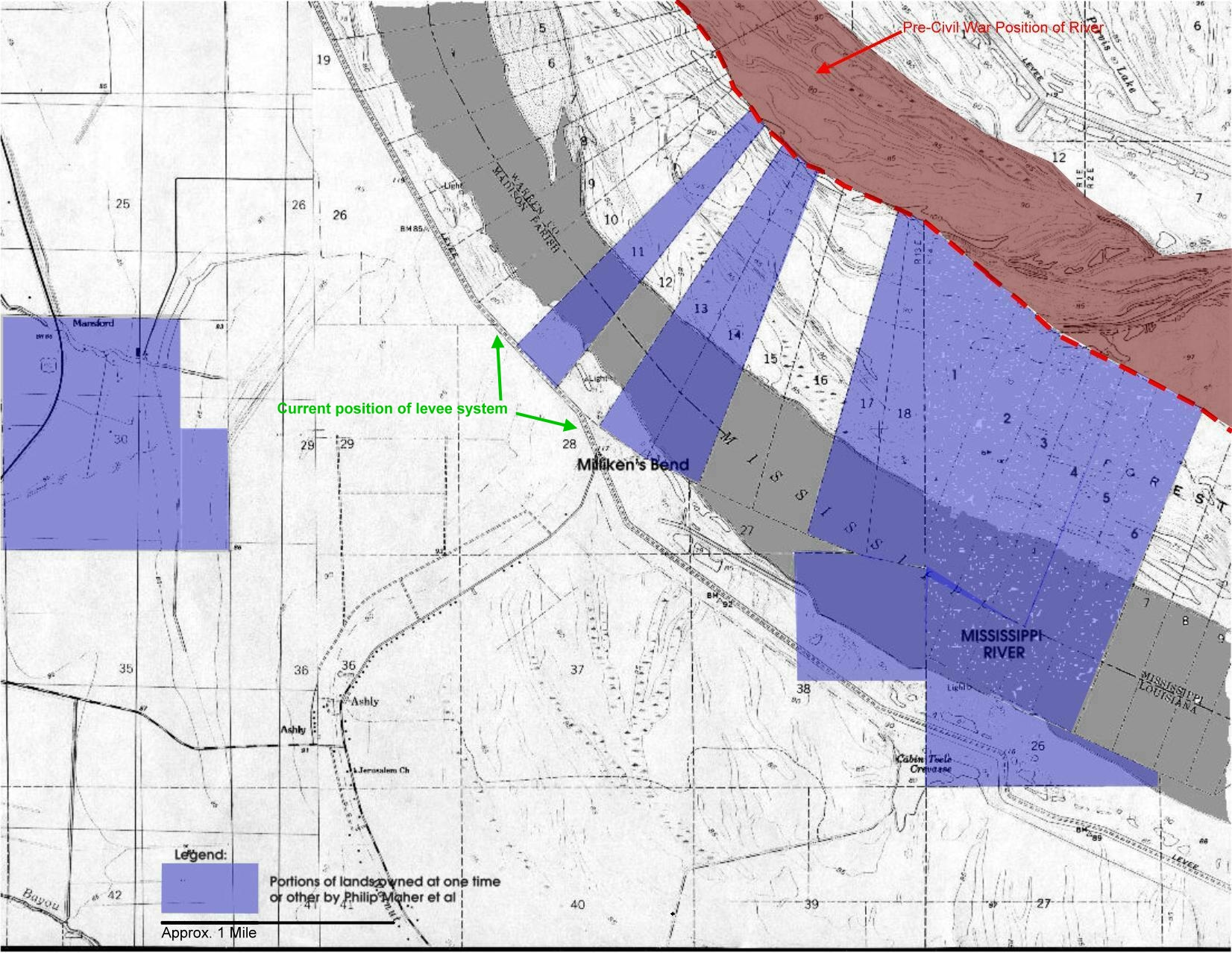
Part of land in Milliken's Bend area
known to have been owned by Philip Maher. Note the location of the land relative
to: (I) the pre-Civil War position of the River; (2) the current position of
the
River; and (3) the current levees. (From Maher
Family of Madison Parish (Richard P. Sevier 2005.)
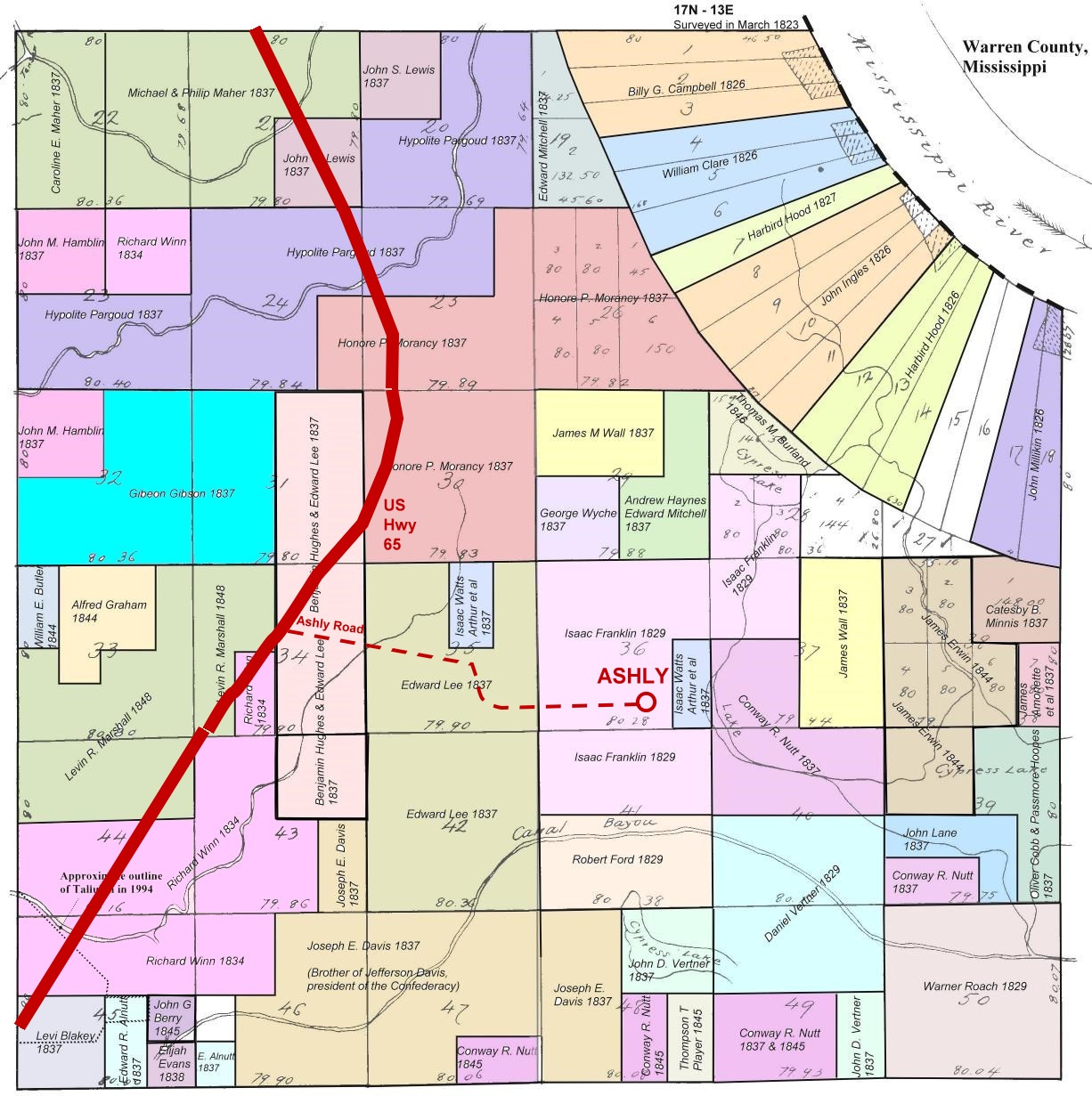
T17N-R13E (Modified) From
Madison Parish, Louisiana Earliest Landowners (Richard P. Sevier
2009)
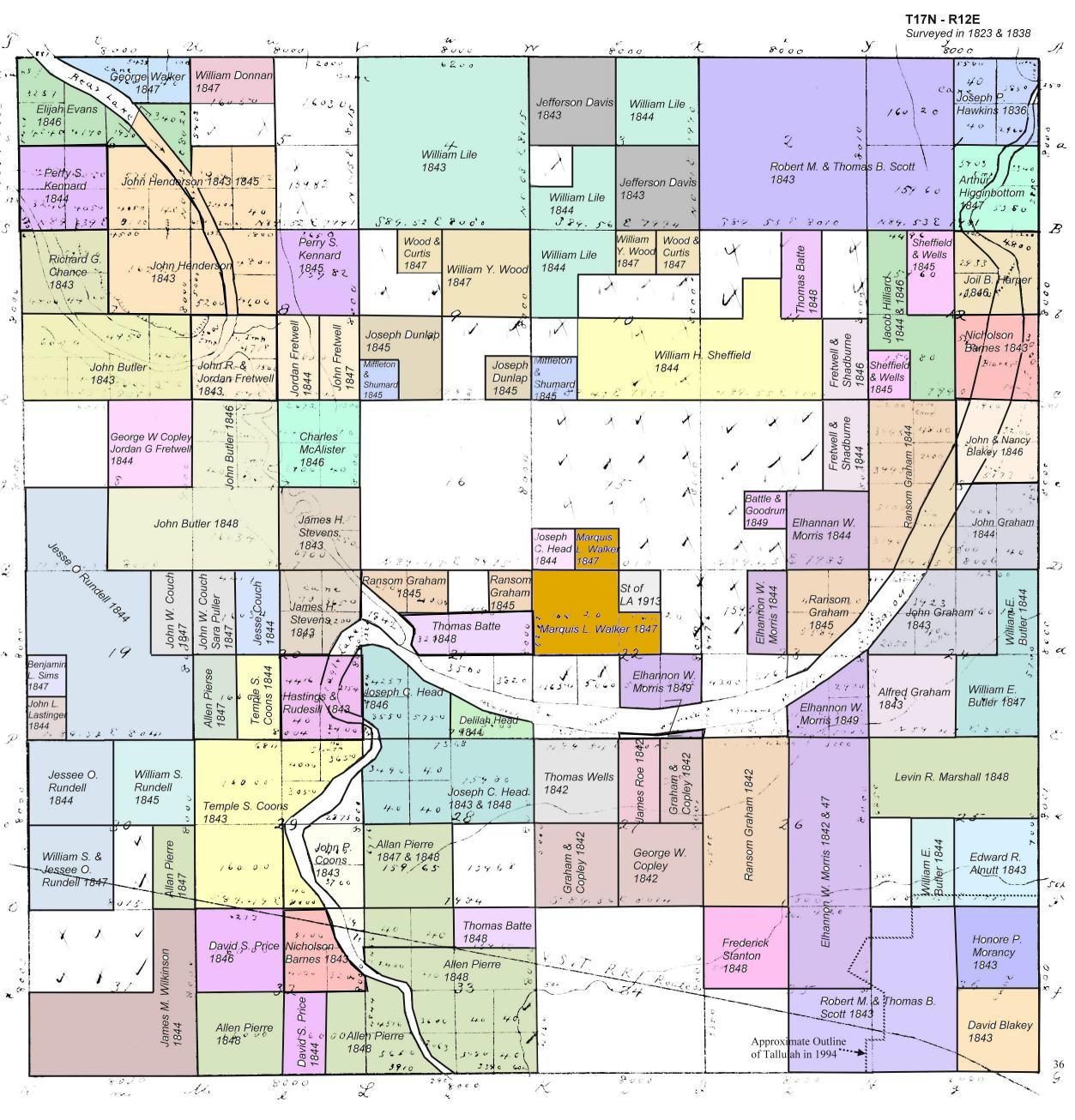
T17N-R12E From
Madison Parish, Louisiana Earliest Landowners (Richard P. Sevier
2009) Showing Lands Known as "Ashly West"
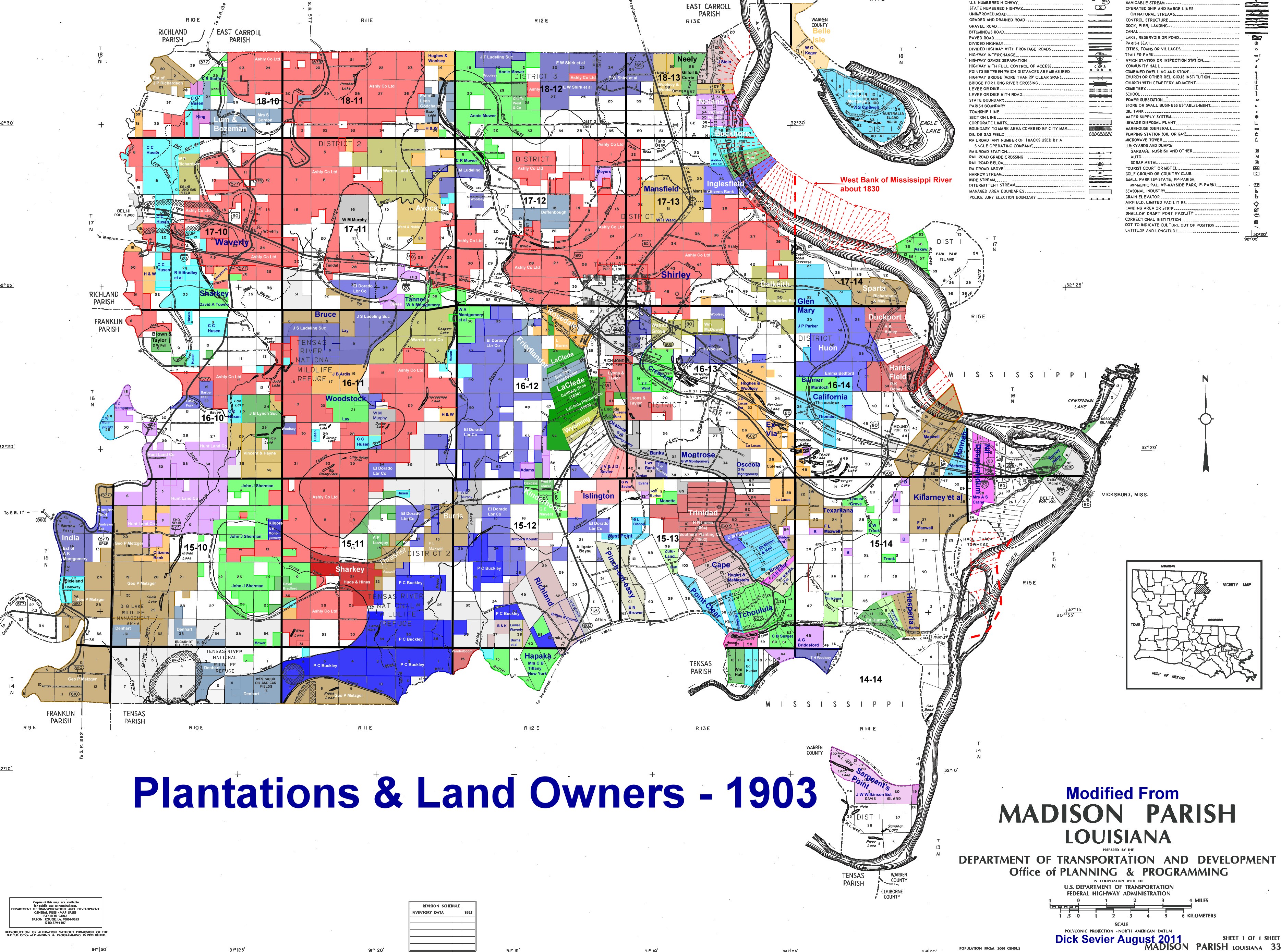
1903 Plantation Owner Map
from Madison
Parish Plantations and Plantation Owners (Richard P. Sevier 2011)
Ashly Co. Ltd.
Lands in Red
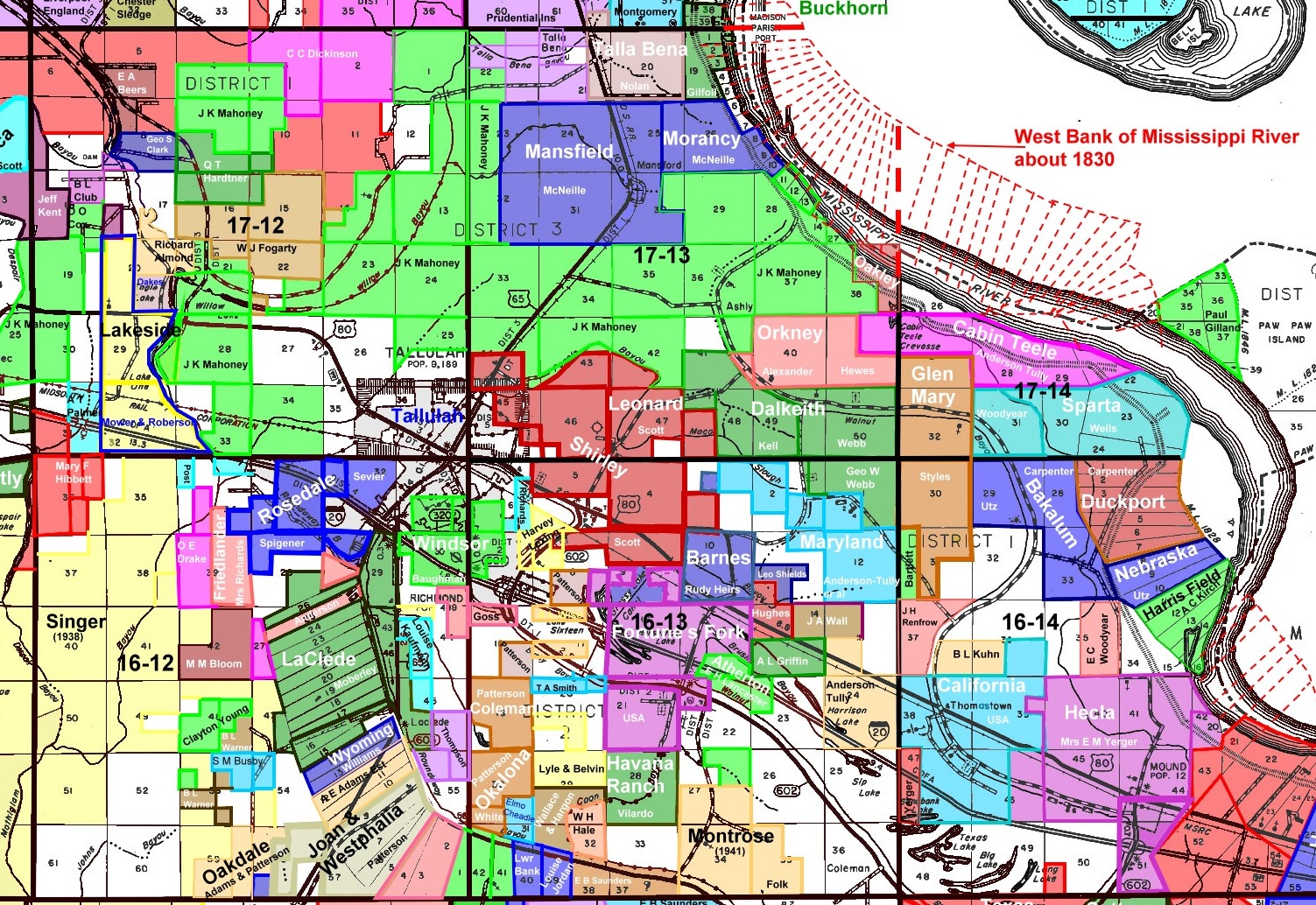
1943 Plantation Owner Map from Madison
Parish Plantations and Plantation Owners (Richard P. Sevier 2011)
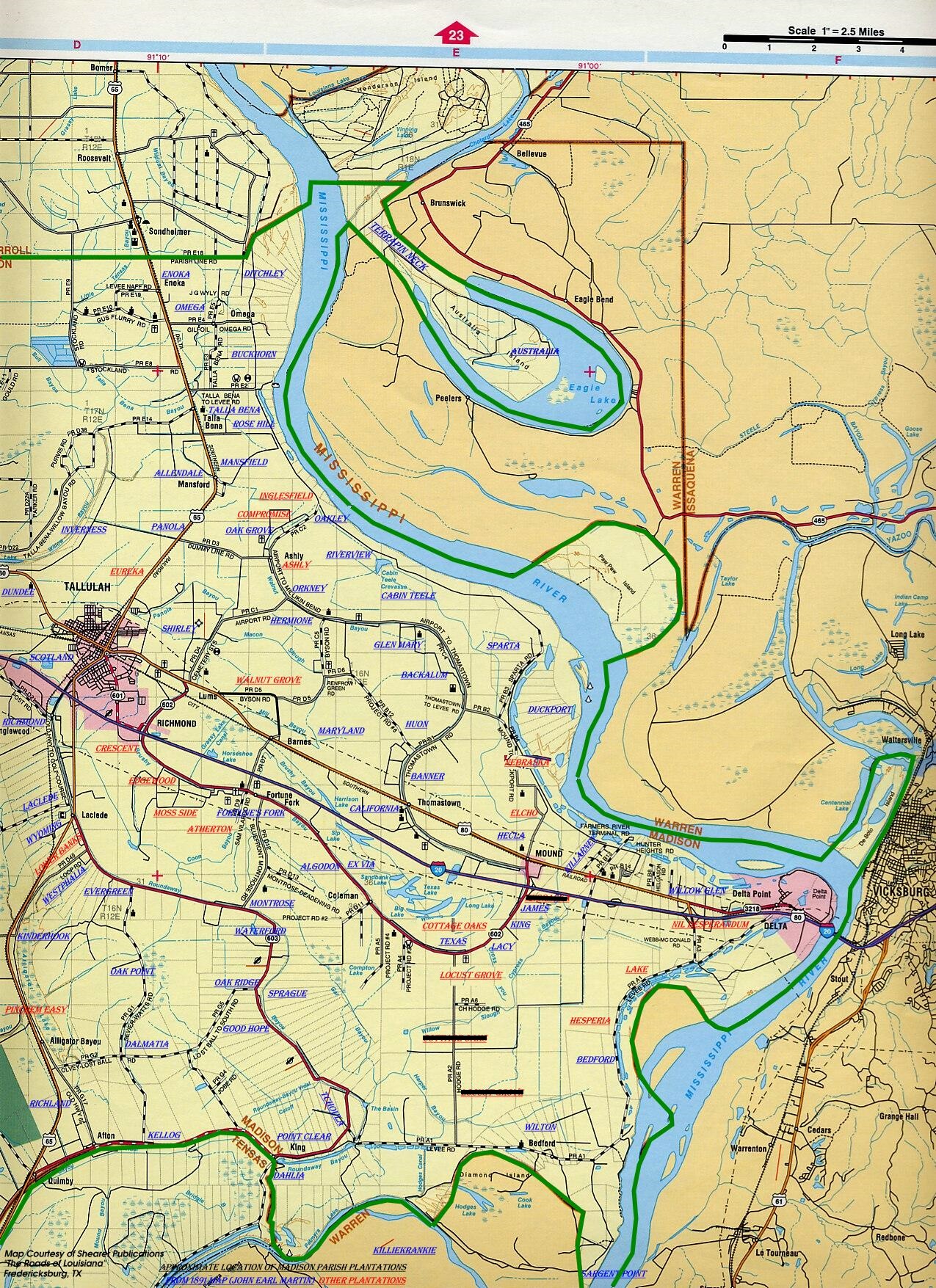
Modified from Madison
Parish Plantations-East
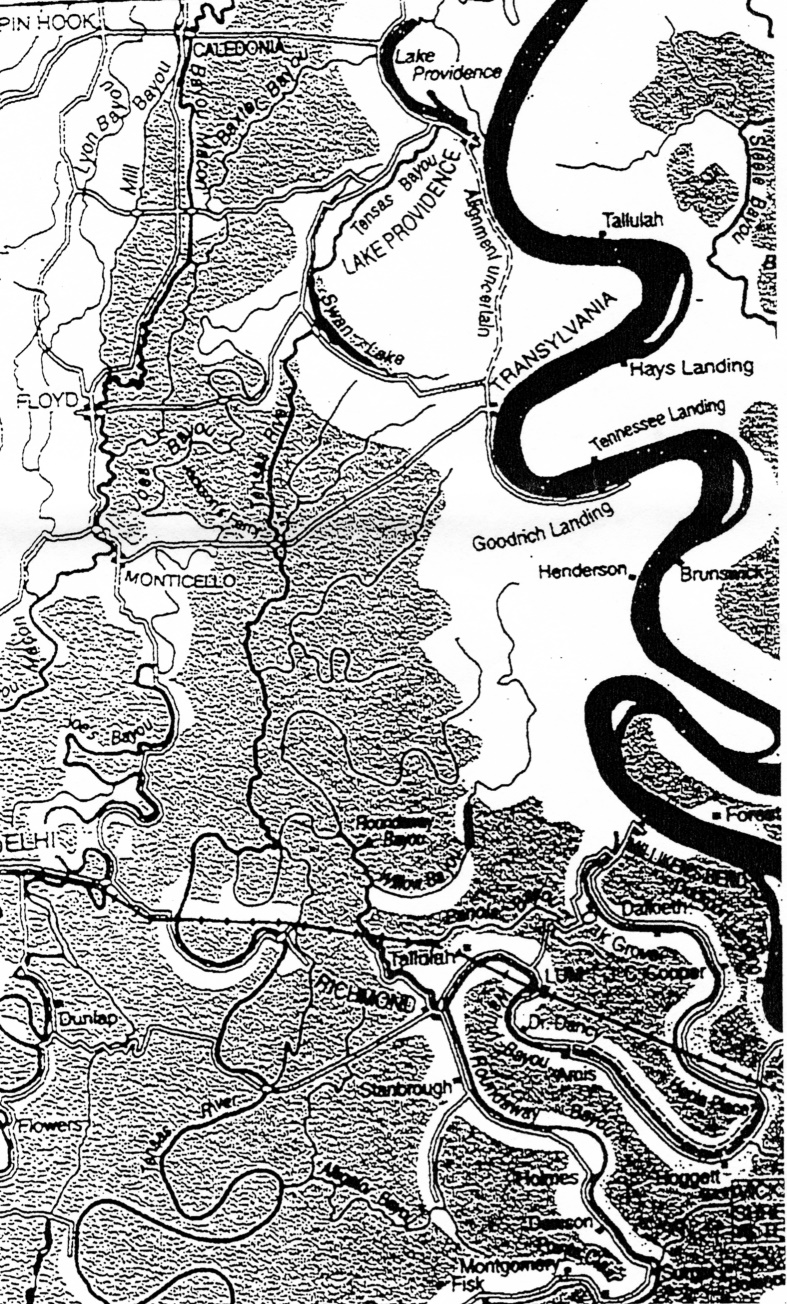
Map showing areas subject to annual
flooding prior to advent of levees (Courtesy of Ken Bales)
PHOTOGRAPHS
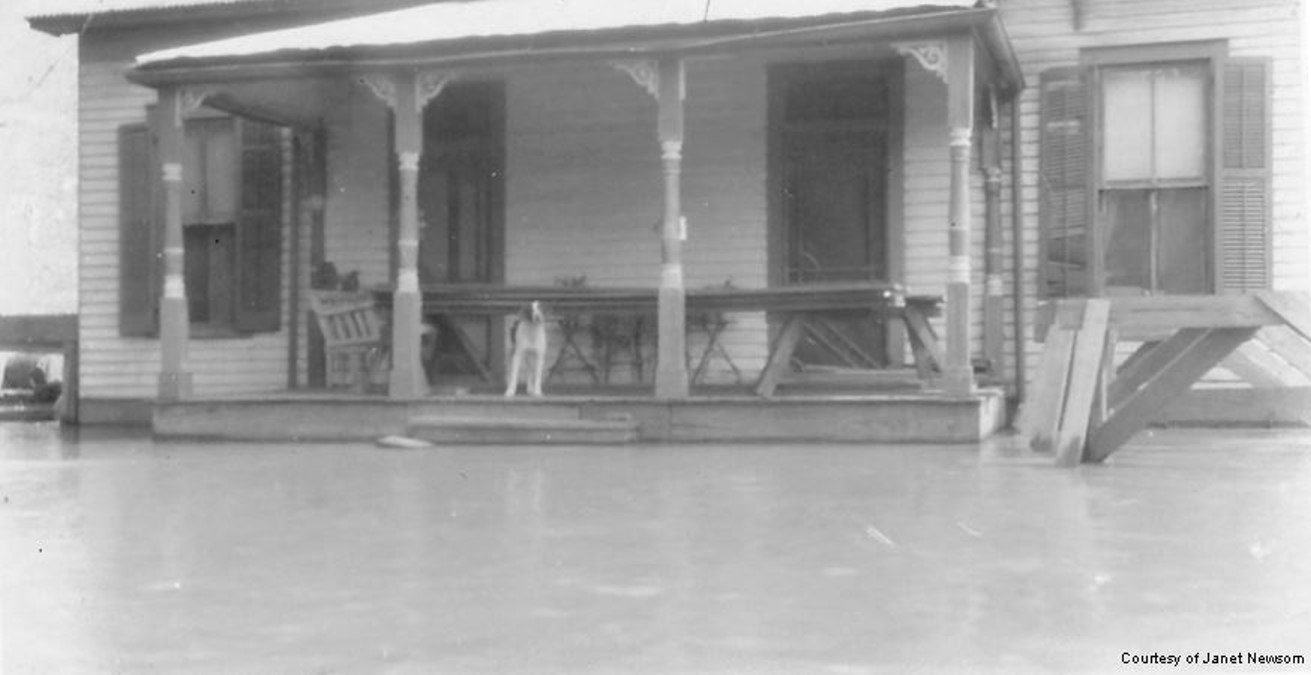
Clark Byram House at Ashly - 1927
Flood
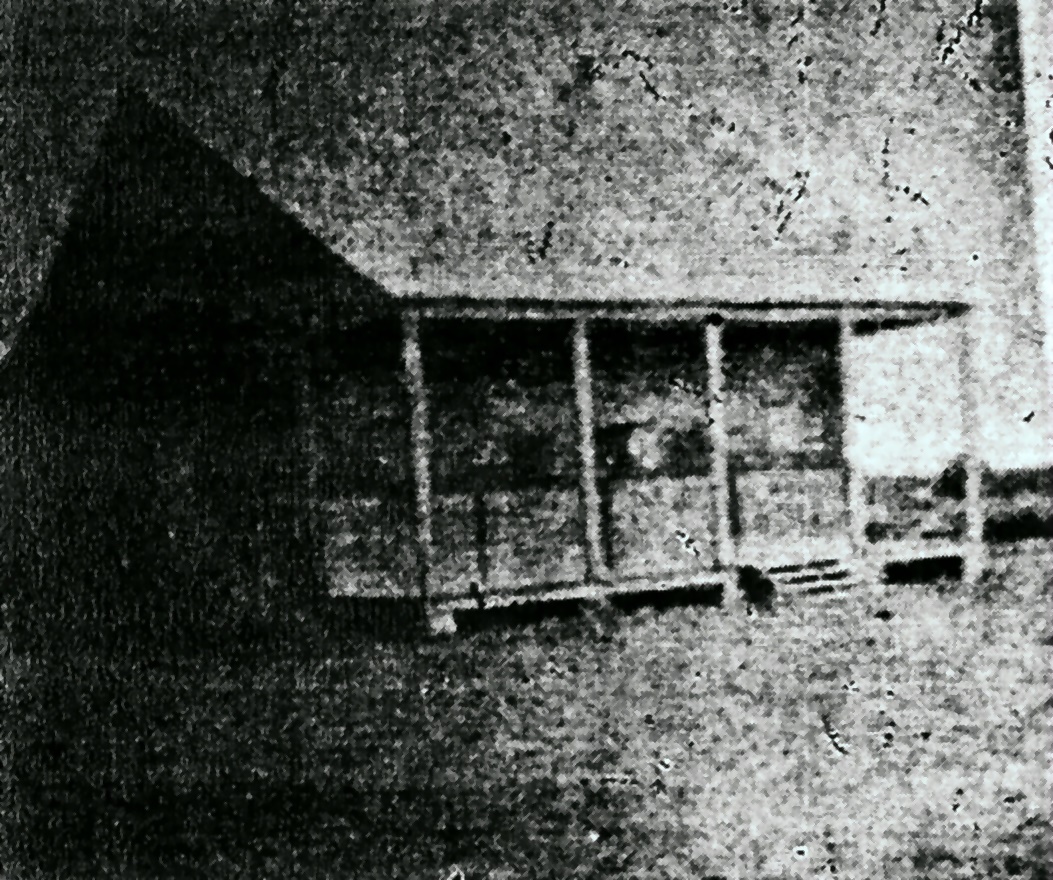
Martin House at Ashly 1939 (Courtesy of J. E. Martin)
CREDITS
MADISON PARISH CLERK'S OFFICE
DICK SEVIER'S MADISON PARISH WEBSITE
MR. C. H. MURPHY, JR.'S 1994 "REPORT TO THE BOARD"
PERSONAL CONTACTS
GEORGIA JOHNSON
JOHN GOSS
TOMMY BISHOP
BILL LAMBERT
JIM McDANIEL
GENEVA WILLIAMS FOR TYPING AND FORMAT.
Endnotes
1. From History of
Madison Parish by Minnie Murphy (1936-37 WPA Project)
2. Mrs. Jennie Witherow,
former resident of Milliken's Bend.
3. Mrs. Charles
"Coltharp, former resident of Milliken's Bend, Mrs. W. D. Ziegler of
Tallulah, compiler of pamphlet on Parish history
4. The late J. H.
Giifoil, of Omega, La. Who attended this "Academy", here laying the
foundation of his afterward brilliant career.
5. Historical
Encyclopedia Britannica--Volume 28, Page 21—fifteenth Edition
6. ibid
7. Murphy Oil Corporation C
Murphy. Jr. report to the board
8. Interview of Ms Georgia Johnson
9. Father of Mississippi Morris--see Brokenburn
10.
Head & Morris owned most of Ashly West
11. A term paper by Miss Frances Alexander in 1941.
Reproduced by Hermione Museum for Reference
12. Walker's Texas Division by Robert Lowe, 2004 p. 96
"Albert Blessington, Confederate private tells of marching by several
trenches 3'x50' dug beside the road to bury the dead Confederates from the
Battle of Milliken's end, and the awful scenes at negro cabins used as hospitals
as they were marching back to Richmond from Milliken's Bend